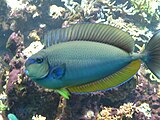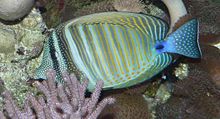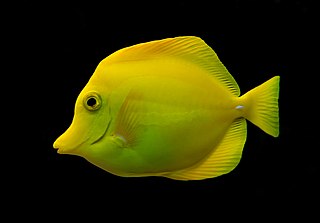
The yellow tang, also known as the lemon sailfin, yellow sailfin tang or somber surgeonfish, is a species of marine ray-finned fish belonging to the family Acanthuridae which includes the surgeonfishes, unicornfishes and tangs. It is one of the most popular marine aquarium fish. It is bright yellow in color, and it lives in reefs. The yellow tang spawn around a full moon. The yellow tang eats algae. The yellow tang has a white barb, located just before the tail fin, to protect itself.

Zebrasoma is a genus of marine ray-finned fishes belonging to the family Acanthuridae which includes the surgeonfishes, unicornfishes and tangs. These fishes are found in the Indo-Pacific region.

Acanthurus is a genus of marine ray-finned fish belonging to the family Acanthuridae, which includes the surgeonfishes, unicornfishes and tangs, found in the Atlantic, Indian and Pacific Ocean. They are found in tropical oceans, especially near coral reefs, with most species in the Indo-Pacific but a few are found in the Atlantic Ocean. As other members of the family, they have a pair of spines, one on either side of the base of the tail which are dangerously sharp.
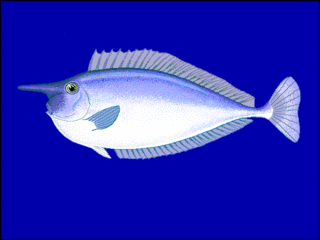
Naso is a genus of marine ray-finned fishes belonging to the family, Acanthuridae, the unicornfishes, surgeonfishes and tangs. The fishes in this genus are known commonly as unicornfishes because of the "rostral protuberance", a hornlike extension of the forehead present in some species. Unicorn fish are popular with spearfishermen and may be cooked by grilling them whole. Unicornfish primarily live around coral reefs and eat mostly algae. It is very popular in Maldives.
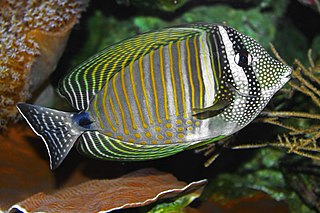
Zebrasoma desjardinii, the Red Sea sailfin tang, Desjardin's sailfin tang, Indian sailfin tang or Indian sailfin surgeonfish, is a species of marine ray-finned fish belonging to the family Acanthuridae, the surgeonfishes, unicornfishes and tangs. This fish is found in the Indian Ocean.
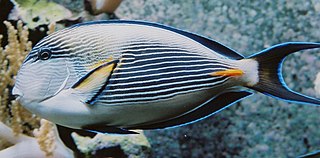
The sohal surgeonfish or sohal tang, is a species of marine ray-finned fish belonging to the family Acanthuridae, which includes the surgeonfishes, unicornfishes and tangs. This fish is found in the northwestern Indian Ocean.
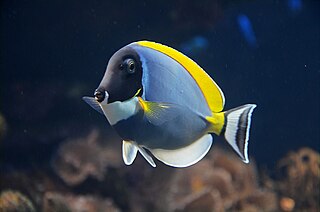
Acanthurus leucosternon, commonly known as the blue surgeonfish, powder blue tang or powder-blue surgeonfish, is a species of marine ray-finned fish belonging to the family Acanthuridae, the surgeonfishes, unicornfishes and tangs. This species is found in the Indian Ocean.

Ctenochaetus, or bristletooth tangs, is a genus of marine ray-finned fish belonging to the family Acanthuridae, which includes the surgeonfishes, unicornfishes and tangs. These fishes are found in the Indo-Pacific region. They have many, small flexible teeth and some species have the common name bristletooth.
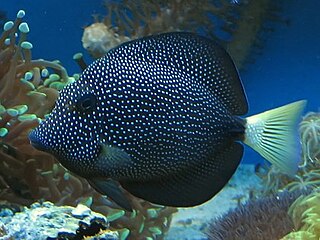
Zebrasoma gemmatum, the gem tang, jewelled tang, spotted tang or Mauritian tang, is a species of marine ray-finned fish belonging to the family Acanthuridae which includes the surgeonfishes, unicornfishes and tangs. This species is found in the Western Indian Ocean. The spotted tang is a highly prized specimen by marine aquarists and often commands high prices.
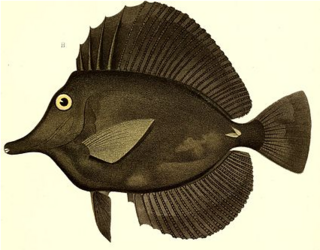
Zebrasoma rostratum, the longnose surgeonfish, longnose tang or black tang, is a species of marine ray-finned fish belonging to the family Acanthuridae, which includes the surgeonfishes, unicornfishes and tangs. This fish is found in the western central Pacific Ocean.

Acanthurus olivaceus, the orange-band surgeonfish, the orange-shoulder surgeonfish or the orangebar tang, is a species of marine ray-finned fish belonging to the family Acanthuridae, this family includes the surgeonfishes, unicornfishes and tangs. It lives in the tropical waters of the Indo-west Pacific.

Zebrasoma scopas, the brown tang, twotone tang, scopas tang or brush-tail tang, is a species of marine ray-finned fish belonging to the family Acanthuridae which includes the surgeonfishes, unicornfishes and tangs. The brown tang is found throughout Oceania and is a herbivorous fish, feeding predominantly on filamentous algae. It is a highly popular fish in the aquarium trade.

The sailfin tang, the Pacific sailfin tang, purple sailfinned tang or sailfin surgeonfish, is a marine ray-finned fish belonging to the family Acanthuridae which includes the surgeonfishes, unicornfishes and tangs. This fish is found in the Pacific Ocean and is popular in the aquarium hobby.
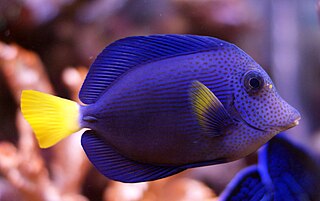
Zebrasoma xanthurum, the purple tang or yellowtail tang, is a species of marine ray-finned fish belonging to the family Acanthuridae which includes the surgeonfishes, unicornfishes and tangs. This species is endemic to the north western Indian Ocean.

Ctenochaetus strigosus, the kole tang, spotted bristletooth, spotted surgeonfish, goldring bristletooth, goldring surgeonfish, yelloweye tang or yellow-eyed surgeonfish, is a species of marine ray-finned fish belonging to family Acanthuridae which includes the surgeonfishes, unicornfishes and tangs. This fish is endemic to Hawaii.

Naso lituratus, the clown unicornfish, orangespined unicornfish, black-finned unicornfish, Pacific orangespined unicornfish, blackfinned unicornfish or stripefaced unicornfish, is a species of marine ray-finned fish belonging to the family Acanthuridae, the surgeonfishes, unicornfishes and tangs. This fish is found in the eastern Indian Ocean and western Pacific Ocean.

The bluespine unicornfish, also known as the short-nose unicornfish, is a species of marine ray-finned fish belonging to the family Acanthuridae, the surgeonfishes, unicornfishes and tangs. This species is found in the Indo-Pacific. It is occasionally found in the aquarium trade. It grows to a size of 70 cm in length. It is called kala ('thorn') in Hawaii, dawa in New Caledonia, and ta or tā in Fiji.

Ctenochaetus hawaiiensis thechevron tang, black surgeonfish, Hawaiian bristletooth, Hawaiian kole or Hawaiian surgeonfish is a species of marine ray-finned fish belonging to the family Acanthuridae which includes the surgeonfishes, unicornfishes and tangs. This fish is found in the tropical Pacific Ocean.

Naso elegans, the elegant unicornfish, the blonde naso tang, Indian orange-spine unicorn, lipstick surgeonfish, lipstick tang, orangespine unicornfish or smoothheaded unicornfish, is a species of marine ray-finned fish belonging to the family Acanthuridae, the surgeonfishes, unicornfishes and tangs. This species is found in the Indian and western Pacific Oceans.
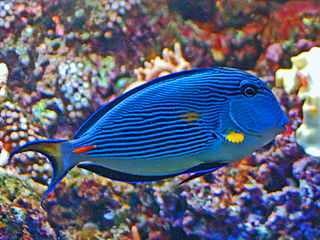
Acanthurinae is a subfamily of marine ray-finned fishes belonging to the family Acanthuridae, found in the Indo-Pacific and the tropical Atlantic. These fishes commonly have the English names surgeonfishes or tangs.









